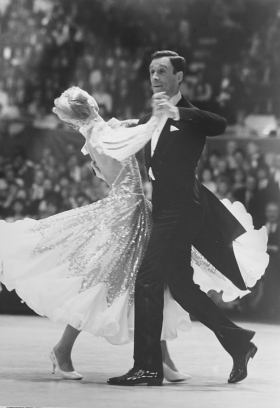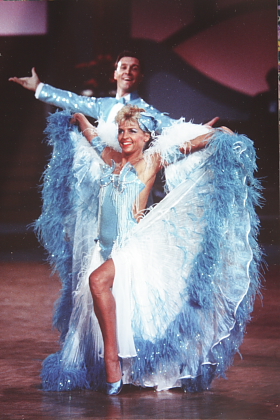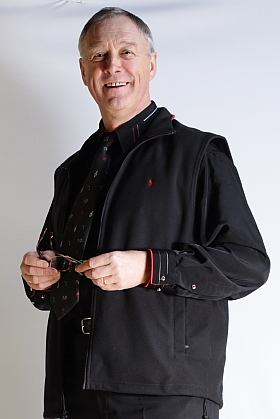1
Meet The Legend: Werner Führer.
Text: Kerstin Lange
Photography: Portraits of Werner Führer: Helmut Römhild / Others: courtesy of Werner Führer.

|
To stay at the top for several years, to be a world class dancer in Ballroom as well as in Latin is extremely difficult if not impossible today.
To be able to vary the basic steps and moves in a way that the dancer can over or underdo a turn –
that’s called floorcraft which means to take advantage of whatever the floor has to offer, using experience, skill and
the ability to anticipate the moves of the competition to find space to perform.
From somebody else this would sound like a platitude, coming from Werner Führer it sounds as true as it can be:
|
Werner Führer
|
with wife Ingrid In many courses and workshops at home and abroad Ingrid and Werner Führer explained their point of view on dancesport. |
Floorcraft
“To be able to show the full skill and perform the individual choreography, combined with flexibility and creativity to react if anything interferes with the performance.” (Training of Judges, 2001)
The ‘floor’ on which Ingrid und Werner Führer performed was anything but wide and open.
The headline “The Führers want to quit” was a hoax, but coming very close to the truth.
Ingrid und Werner Führer are taking over the lead and nothing can stop them to end the almost traditional British dominance –
when totally unexpected the ‘German’ judge decides to rate the Führer’s performance a 2 instead of showing the 1 which was anticipated by dancers and
audience alike.
Audience and dancers are shocked,
the German head coach Wolfgang Opitz looses his temper:
“I can’t believe it! One year of training lost. This Quickstep has to be rated 1.
Why on earth does the German judge rate down the German pair, he of all people?”(Hamburger Abendblatt, 27.10.1975)
A simple mistake while the judge calculates the overall ranking disqualifies the Führers’ top performance and almost ruins their career,
destroying more than just a year of preparation.
A career in dancesport is not in focus when Werner Führer starts to dance in 1963. He works for the German Treasury, holding a degree
in Finance while he learns his basic moves in a Hamburg club, the TTC Harburg.
Dancers find a lot of opportunities in the Sixties, clubs turning into sportsclubs, in the city of Hamburg the two large dancers’
associations HTV and HATV come together as HATV, now representing dancers on the national level.
Competition dancing in Hamburg is a small world, a network of dancers for dancers: The chairman of HATV, Hans Christen, is also involved in the ‘Deutsche Sporthilfe’,
in other words: able to channel government money into Hamburg’s dancesport. His successor Heinz Riehn competes with Werner Führer for the first place –
in the beginners course of a dancing school.
As Werner Führer, by now a member of the TTC Formation, becomes successful, the Federal Army puts an a end to his sport: While Werner Führer is in the Service
he and his dancing partner break up.
Germany’s head coach Opitz can help and introduces a new lady to Werner Führer,
probably not having the faintest idea that he is starting the career of Germany’s most successful pair, Ingrid und Werner Führer.
Presentation.
“Dancing is a visual art, the image created by a dancing pair is very important. A pair has to present this image to the judges” (Training of Judges, 2001)
Dancing means: to perform. And behind this there is the intention to compete, to accept the challenge, to enter the floor – again and again
We competed even in Cape Town, in 1972 with the Formation, in that difficult political situation.
And there were Sydney, Montreal, New York, Rio de Janeiro, Tokyo ...”
In 1966 the Führers start to dance in Blackpool. From then on they appear wherever the best meet to match their skills.
What counts is to dance, to work, to persevere, to move forward.
“We won’t give up” – not only a newspaper headline in a 1975 edition of theHamburger Abendblatt, also the Führers’ ‘credo’.
In 1976 they eventually become Amateur World Champion, this time in the ‘10 Dances’.
But this is not the end: After turning professionals in 1980 the Führers overcome the British dominance in professional dancing,
the international top dancers have to accept the fact that from now on Germany has a place on the podium.
“From 1976 until 1979 the first three in professional competitions were always Gleave, Barr, Kezuka/ Yamamoto. Then we made it. And I would say this was our greatest success:
In 1980 we finished the World Championship in Perth, Australia, making the third place.”
And they make 2nd place in the World Championship ‘10 Dances’ and in 1982 again: 2nd place in the Ballroom World Championship as well as
in the ‘10 Dances’ World Championship.
“In 1982, in New York, we made only the fourth and fifth place, and two times, in Japan, we even missed the finals. But from 1978 until 1985 we were always among the first five on the World Ranking List”
Werner Führer shows a newspaper clipping, a snapshot.
It shows two pairs dancing the Viennese Waltz, Barr und Führer, the same movement, the ladys’ robes swinging in time, poise and posture almost identical,
almost like a reflection ...
“We are dancing on the ‘outside track’,” Werner Führer points out and I can hear pride as he explains the situation. “You see?
We are overtaking the English couple – on the ‘outside track’.”
To Translate Musik into Movement.
“The term ‘Charakteristcs’ refers to what the music wants, the music’s potential: it wants to be pumped, sqeezed, used. It wants to be loved, caressed – not to be flogged! The dancer has to realize music as movement across the floor without breaks, without disruption.” (Training of Judges, 2001)
Only then it is true that if something looks good, it must be good – looking good in the sense of clear, clean, easy to understand.
From 1980 Werner Führer is deactivated as a civil servant, as a professional dancer he has no other choice but to pursue his dancesport career,
full time.
But it is easy for him to switch from civil servant to competition dancer.
“We already had had periods during which had trained seven days a week, for instance in 1974. The step from amateur to professional
was only a small one: our time had come.”
Wolfgang Opitz and Gerd Hädrich, Bill und Bobby Irvine, Benny Tolmeyer, Anthony Hurley are training the Führers until they
are masters in all areas of competions dancing: Latin und International Ballroom, Partner Dancing as well as Formation Dancing.
Ingrid und Werner Führer are the first competition dancers to undergo a medical examination of fitness.
They have the same level of fitness as quarter mile runners – and as Tour de France winner Eddy Merckx.
In 1982 this is the every-day live of Ingrid and Werner Führer:
two to three hours training per day,
each month a trip to Great Britain, to train in the island’s studios: only with perfection in the English Style a competition dancer can move forward.
They earn their living as head coaches of several of Germany’s federal states, they are employed by clubs, they earn money as showdancers, there is prize money.
Dancesport has a lot of publicity, is covered in the media, the large events getting prime time on TV.
Very soon Ingrid and Werner Führer are fully booked, they have to turn down offers, even tempting ones.
Even these days Werner Führer’s schedule is tight
making it difficult to find a free slot for an interview.
In the end we meet half way, having coffee at the Rothenburgsort Holiday Inn close to the bridges spanning the river Elbe.
Awards and honours? Impossible to count.
On the other hand: there is a badge of honour he received in Holland, rarely being giving to a ‘foreigners’ and this of course is something to be proud of.
Official functions? Vice President of Germany’s Professional Dancing Assiciation, Assistant of Germany’s Head Coach, Head Coach of Bavaria, Schleswig-Holstein and Saxony-Anhalt.
He is coach for Hesse, Judge, trainer in several clubs: TCH Harburg, Hannover Blaugelb, TC Concordia Lübeck, CC Winsen, Rot-Weiß Gießen.
‘His’ dancers? A long list, among others he was coach of Asis Khadjeh-Nouri, Christine Heitmann, Andrea and Frank Knief, Stefan Ossenkopp / Pia David, and Klaus Gundlach.
He coaches the Champions of Holland, van Stakenburg as well as Rene und Ivonne Marquard, Anja Schramm / Marcus Weiss, Cathrin Hissnauer / Stanislav Hermann. All over the world he he points amateurs and professionals in the right direction,
in Moskow, too.
“Since approximately fifteen years ago the Russians have become more and more dominant in dancesport”, Werner Führer tells me.
He trains the Russian dancers in the brandnew studios on the Luzhniki Complex, Moskow’s Olympic stadium which shows that he belongs to the elite
of the international trainers – a status that goes along with a rather small fee.
The costs of dancesport are substantial, also in Russia. Sometimes with a bit of luck sponsors will be generous, but in general dancesport is a private affair - to be paid for by the dancers and their families.
Still Blackpool is one of the most important events for dancers and coaches and for Werner Führer as well.
It is an honour for him to be asked to take part as a judge.
“I am not quite sure but I think in the near future I will stop being a judge in Blackpool”, Werner Führer confides.
“Maybe I will take things a bit more easy.”
![]()
©: Ballroom Website, 2009
Updated: 29.04.2009




